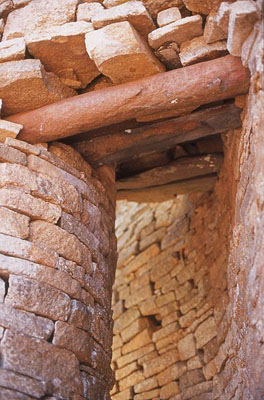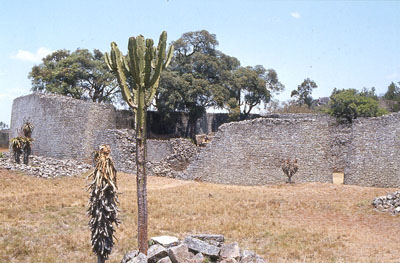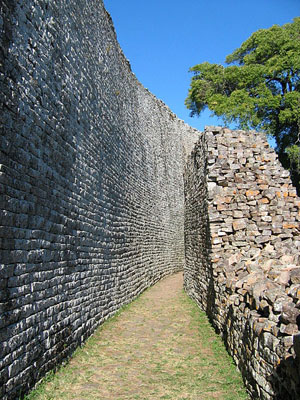The ruins of Great Zimbabwe are considered sacred by the people who live near them. Few people are allowed to visit them, making the deserted city very different from the way it was at its medieval peak, when perhaps 25,000 people thronged its streets and lived in dense housing complexes around the Great Enclosure, where the king lived. Learn more about the bustling world of Great Zimbabwe in this slideshow.
|
A 16th-century Portuguese captain who saw Great Zimbabwe after its fall was still awed by the walls he saw. He called the city “a fortress built of stones of marvelous size," and said "there appears to be no mortar joining them.”
By User:Ulamm (Own work (own photo)) [Public domain], via Wikimedia Commons The great walls of the city were indeed built without any mortar to hold them together, even when they rose to 36 feet high. The skill of the men who made over a million bricks and designed and built the walls made the walls strong and imposing.
By User:Ulamm (Own work (own photo)) [Public domain], via Wikimedia Commons Archeologists believe the society at Great Zimbabwe was strictly hierarchical, and that different classes of society were segregated from each other. The Great Enclosure is filled with narrow passages like this one, which historians believe were used by different classes of people—one set of passages for royalty, one set for nobility, one set for others.
y Vinz at fr.wikipedia [FAL], from Wikimedia Commons |
What do historians believe to be the purpose of the steep stone walls on Zimbabwe Hill?
- to separate the rich and privileged from the poor and common people
- to shut out the glaring African sun and cool the rooms of the rich
- to protect the ruler and his family from attacks by rebel forces
Historians know that the social order in Great Zimbabwe was strict and hierarchical, and they suspect the high walls and winding passages were intended to keep classes of people apart.
Historians know that the social order in Great Zimbabwe was strict and hierarchical, and they suspect the high walls and winding passages were intended to keep classes of people apart.
Historians know that the social order in Great Zimbabwe was strict and hierarchical, and they suspect the high walls and winding passages were intended to keep classes of people apart.
Why was there so much confusion about the origin of Great Zimbabwe?
- There were at least two rival tribal kingdoms in the area who could have built the great city.
- Archeologists were misled by the reports of anthropologists who gathered oral history about the area.
- Europeans who colonized Africa refused to believe that the great city could have been built by Africans.
The Europeans who colonized southern Africa actively promoted the idea that Africans were not "civilized" enough to build a city like Great Zimbabwe.
The Europeans who colonized southern Africa actively promoted the idea that Africans were not "civilized" enough to build a city like Great Zimbabwe.
The Europeans who colonized southern Africa actively promoted the idea that Africans were not "civilized" enough to build a city like Great Zimbabwe.
How do archeologists know that Great Zimbabwe traded with China, India, and the Middle East?
- They have found artifacts that were created in these other regions of the world.
- They have found records of trade transactions with traders from other continents.
- They have found stories about Africans' interactions with people of other regions.
Archeologists who have studied Great Zimbabwe have found glass, metalwork, and other commodities typically offered as exports by these distant cultures.
Archeologists who have studied Great Zimbabwe have found glass, metalwork, and other commodities typically offered as exports by these distant cultures.
Archeologists who have studied Great Zimbabwe have found glass, metalwork, and other commodities typically offered as exports by these distant cultures.
Summary
 Questions answered correctly:
Questions answered correctly:
 Questions answered incorrectly:
Questions answered incorrectly:



